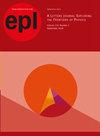Lyman-α森林重子声学振荡模型的选择
IF 1.8
4区 物理与天体物理
Q2 PHYSICS, MULTIDISCIPLINARY
引用次数: 0
摘要
最近发布的莱曼-α重子声学振荡测量的最终完整调查为研究有效红移下的宇宙几何提供了最重要和准确的数据库,而其他来源无法获得这一数据。在本文中,我们使用这些数据在四个不同的宇宙学中进行选择:普朗克∧CDM、宇宙、米尔恩宇宙和爱因斯坦-德西特宇宙。鉴于莱曼-α研究的广度和深度,仅此BAO测量就提供了强有力的模型比较,与之前将莱曼-α数据与较低红移测量相结合的研究相辅相成。尽管这两种方法都很有用,但后者往往会淡化模型预测和观测之间的差异。因此,我们严格根据莱曼-α森林和背景类星体中测得的BAO尺度,研究了这些模型之间的比较。我们发现米尔恩宇宙和爱因斯坦-德西特宇宙被这些数据强烈排除在外。也有强有力的证据不赞成标准模型。莱曼-α的测量结果与由预测的宇宙几何结构完全一致。因此,越来越多的证据表明,广义相对论的零活性质量条件应该是∧CDM的一个重要组成部分。本文章由计算机程序翻译,如有差异,请以英文原文为准。
Model selection with baryonic acoustic oscillations in the Lyman-α forest
The recent release of the final, complete survey of Lyman-α baryonic acoustic oscillation measurements provides the most significant and accurate data base for studying cosmic geometry at an effective redshift , which is inaccessible to other sources. In this paper, we use these data to select among four distinct cosmologies: Planck ΛCDM, the universe, the Milne universe and the Einstein-de Sitter universe. Given the breadth and depth of the Lyman-α study, this BAO measurement alone provides a strong model comparison, complementary to previous studies that combined Lyman-α data with measurements at lower redshifts. Though both approaches are useful, the latter tends to dilute the disparity between model predictions and the observations. We therefore examine how the models compare to each other strictly based on the BAO scale measured in the Lyman-α forest and background quasars. We find that the Milne universe and the Einstein-de Sitter universe are strongly ruled out by these data. There is also strong evidence disfavoring the standard model. The Lyman-α measurements are completely consistent with the cosmic geometry predicted by . As such, evidence continues to grow that the zero active mass condition from general relativity ought to be an essential ingredient in ΛCDM.
求助全文
通过发布文献求助,成功后即可免费获取论文全文。
去求助
来源期刊

EPL
物理-物理:综合
CiteScore
3.30
自引率
5.60%
发文量
332
审稿时长
1.9 months
期刊介绍:
General physics – physics of elementary particles and fields – nuclear physics – atomic, molecular and optical physics – classical areas of phenomenology – physics of gases, plasmas and electrical discharges – condensed matter – cross-disciplinary physics and related areas of science and technology.
Letters submitted to EPL should contain new results, ideas, concepts, experimental methods, theoretical treatments, including those with application potential and be of broad interest and importance to one or several sections of the physics community. The presentation should satisfy the specialist, yet remain understandable to the researchers in other fields through a suitable, clearly written introduction and conclusion (if appropriate).
EPL also publishes Comments on Letters previously published in the Journal.
 求助内容:
求助内容: 应助结果提醒方式:
应助结果提醒方式:


